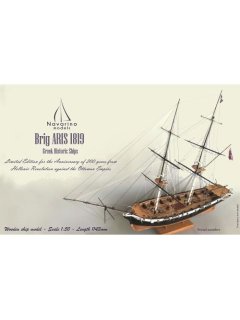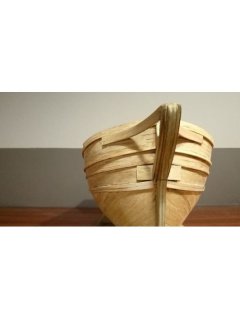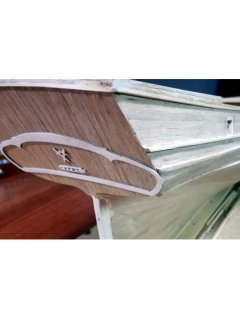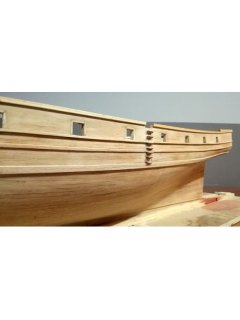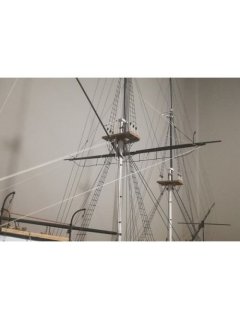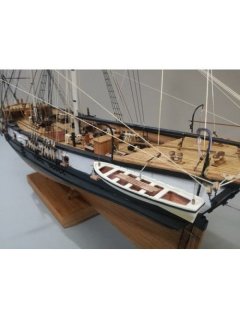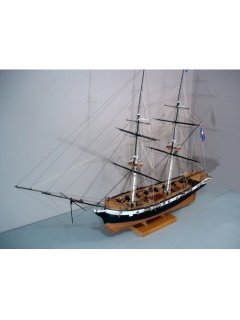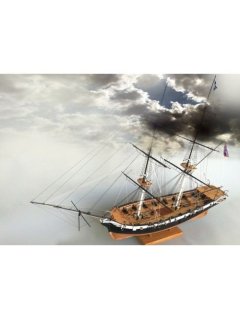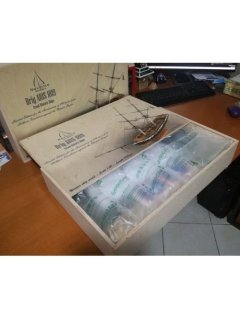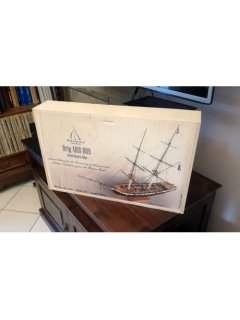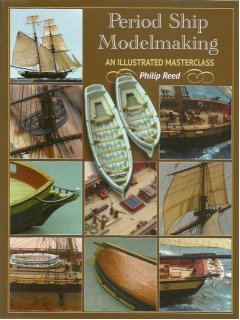Brig ARIS, Navarino Models
- Brand: Navarino Models
- Product Code: D17612 [17612]
- Availability: Available within 1 - 3 business days
- Date added: 30/09/2020
This product belongs to the following categories:
-
577.00€
HISTORICAL GREEK SHIP: Brig ''ARIS'' 1819, 1/50 Scale Wooden Kit.
Limited edition wooden ship model for the anniversary of 200 years from Hellenic Revolution against the Ottoman Empire.
The kit is offered to a birch plywood box (55X35X11cm) with printed image on the sliding lid.
Each kit has engraved the unique serial number engraved.
Historical Reference:
The brig as a type of vessel appears somewhere in the late 17th or early 18th century, with the name "brigantine" in the waters of Northern Europe. In the Mediterranean the name is much earlier, since the 15th century and is referred to as "pergende" as a small warship. The first "brigantine" in the northern seas was sailboat, with two masts, carrying two rectangular sails in the float and a boom in the aft. During the 18th century, the brigantines evolved, acquiring more square sails in both masts.
In Greece brigs spread mainly in the second decade of the 18th century, and their shipbuilding continued until the end of the 19th century. There is evidence of the first brig construction in Hydra in 1757.
At the era of the Napoleonic Wars (1797-1813), Greek ship owners were golden opportunity to close the gap on trade between eastern and western Mediterranean, with great risk and huge profits. The success of the brig was so great that in a few years Hydra and Spetses built a lot, both in the shipyards of the islands and abroad, mainly in Italy.
From the archives of Hydra, it appears that the island in 1813 had 106 large ships sailing with flags of different countries and 27 small.
But with the end of the Napoleonic Wars and the defeat of Napoleon Bonaparte, restored peace to Europe were lifted exclusions and merchant shipping came back in the hands of western European competitors, especially the British. There followed a fall in the price of grain falling Greek merchant shipping and economic recession. The Hydra ships, which traveled with profits exceeding 100%, reached on the eve of the Greek Revolution in lower earnings limit of 18% to 13%, or about trips passive.
In 1818, in the midst of the economic crisis, Anastasios Tsamados, with the collaboration of his relatives Dimitrios and Michael Tsamados and the co-workers of Vasilios Bondouris and Anagnostis Yourdis, builds in Venice brig “Aris” under the property of co-ownership.
"Aris” was built of oak wood and had a capacity of 350 tons, a keel length of 31.5 m., width in the middle frame 8.85m. & a draft of 4.90m. Its building cost 167,340 pips.
It was built as a merchant ship and was initially equipped with 18 12-liter guns (liter of French weight unit, equal to 6 ounces), and later with 2 12-liter guns and 10-pound 18-liter guns to face sudden pirate raids.
With the outburst of the Greek Revolution, "Aris" commanded by Anastasios Tsamados, joined the Hydra fleet, actively taking part in almost all of his naval operations in the Aegean Sea, the Peloponnesian coasts and the northern Corinthian.
However, the fame and glory of this emblematic ship due them especially to the Navarino episode. In April 1825....
Manufacturer: Navarino Models
Scale: 1/50
Length: 1143 mm
Condition: NEW.
Shipping weight: 2.3 Kg.
...Opening the box
Before you begin model building, it is a good idea to study the model plans as well as the materials provided.
Plans: Six sheets of drawings are provided, including bird eye view & profile of the model, profile of the keel & the position of the bulkheads, detail of the hulls construction, rigging plan & details. Study them and try to construct the individual parts of the model as shown in the drawing. The plans are on a scale of 1/50, with the exception of those showing the individual details. So you can take measurements directly from the plan. There is a case that you need to change a certain dimension for the purpose of implementing the material.
Wooden parts: Strips & dowels available in the kit are given in various profiles depending on use. In the list of materials given on separate page, you may be informed about the main use of each material. Before using a strip or dowel, please do the necessary check of the profile and cut the wood to the right length. Especially for the planking strips, do not use the entire length of it. For example 10cm length in a 1/50 scale, means 5m in actual length. This length is in fact relatively long (sometimes 3-4m), so someone can manage it. There are parts of the model where you need to dip the strip in tepid water to make it easier for them to get their form. Keel, bulkheads as well as the superstructures, are given to you by plywood, and provide great durability and stability.
Metal parts: In the kit you will find metal objects made of bronze or copper. Some of them are ready for use and others need to be formed. The ready-made ones, such as cannons, can be "cleaned" by rubbing them with fine paper and fine blotting paper, and then if you want to get them aged, dip those in a solution that you can buy from a handicraft shop. The metal parts you need to shape cut them off with a good pair of scissors or a goldsmith's jeweler. If you use a power tool to drill it, hold the piece with a wooden stick and with a tweezer to avoid burning because it will heat up by friction.
Resin parts: Also, inside the kit you will find parts of the model made of resin. Before painting, it is advisable to wash them with lukewarm water and dishwashing liquid. Next you have to prime them with gloss black paint and paint them in their color. To glue them, use CA glue.
BASIC TOOLS YOU WILL NEED: Pliers, hammer (a small one), saws, chisels, knives, files, drills, electric plank bender or a mini travel iron, rasps (flat & half round), needle threaders, tweezers, rulers, squares, compass, awl, clamps, sanding blocks (small wood blocks, ice cream sticks), sandpaper (aluminum oxide is best), hobby plane, vice, scissors, pins, drills.
Colors selection: Initially it is advisable to choose to paint your model with model's colors. They are produced exclusively for modeling use. The choice of the company is yours. You will also choose whether to be acrylics or enamels. Another alternative is oil painting. But they require more time to dry.
Varnishes: Independently of whether the way to apply them is by brush or spray, it will be nice to use matt or satin performance. Gloss, we use it in special cases such on a sailing yacht.
Brushes: Use good quality with round, pointed and flat nose. Depends on the surface you will paint. Clean them thoroughly after the end of work and at the end of the day, wash them with dishwashing liquid or hair shampoos.....
Related Products
Period Ship Modelmaking, Philip Reed, Seaforth
PERIOD SHIP MODELMAKING - AN ILLUSTRATED MASTERCLASS: The Building of the American Privateer ''Princ..
30.90€ Ex Tax: 29.15€

